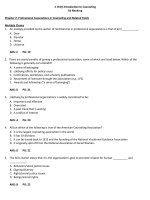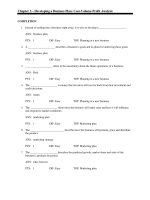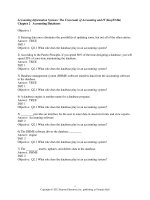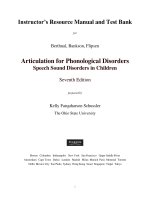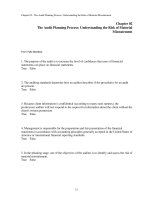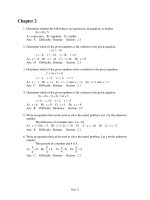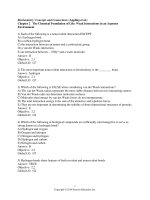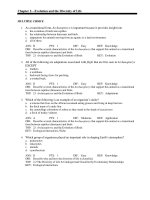Government matters american democracy in context 1st edition maltese test bank
Bạn đang xem bản rút gọn của tài liệu. Xem và tải ngay bản đầy đủ của tài liệu tại đây (465.04 KB, 20 trang )
Government Matters
Chapter 02: The Founding and the Constitution
Multiple-Choice Questions:
1. Laborers who entered a contract to work for no wages for a fixed period of time in return for
food, clothing, shelter, and their transportation to the colony were known as:
a. indentured servants.
b. minutemen.
c. coolies.
d. apprentices.
e. journeymen.
Answer: a
Bloom’s: Remember
Difficulty: 1
Text Answer Hint: The American Colonies
Page: 37
Teaching Emphasis: The Founding and the Constitution
2. Which of the following is true of the differences and commonalities among the colonists?
a. Property ownership was very rare among the colonists.
b. The colonists were predominantly of English descent.
c. Ownership of property was not a prerequisite for voting.
d. The colonists were overwhelmingly Catholics.
e. The colonists were mostly financial investors.
Answer: b
Bloom’s: Understand
Difficulty: 2
Text Answer Hint: The American Colonies
Page: 38
Teaching Emphasis: The Founding and the Constitution
3. Which of the following is true of the early colonial government?
a. The colonists had to strictly follow the king’s laws.
b. Events in England during 1600s increased the influence of the king.
c. The colonies enjoyed a considerable degree of autonomy from England.
d. In most colonies, the people elected the governors.
e. The assemblies depended on the governors for funding.
Answer: c
Bloom’s: Understand
Difficulty: 2
Text Answer Hint: The American Colonies
Page: 38
Teaching Emphasis: The Founding and the Constitution
© 2013 by McGraw-Hill Education. This is proprietary material solely for authorized instructor use. Not authorized for sale or distribution in
any manner. This document may not be copied, scanned, duplicated, forwarded, distributed, or posted on a website, in whole or part.
4. Which of the following documents served as the basis for the guarantees in the fifth and
fourteenth amendments of the U.S. Constitution that government shall not take a person’s
life, liberty, or property without due process of law?
a. The Dongan Charter
b. The Pacta Conventa
c. The Nowell Codex
d. The Magna Carta
e. The Charter 08
Answer: d
Bloom’s: Remember
Difficulty: 1
Text Answer Hint: The American Colonies
Page: 39
Teaching Emphasis: The Founding and the Constitution
5. If a monarch believes in the divine rights of the king, he is most likely to believe that he:
a. has absolute control over the legislature in his land.
b. is accountable to his subjects.
c. should take his subjects’ opinion before making a law.
d. should keep the Priests in his land happy.
e. should take the opinion of the wealthiest people in his land before passing a law.
Answer: a
Bloom’s: Understand
Difficulty: 2
Text Answer Hint: The American Colonies
Page: 39
Teaching Emphasis: The Founding and the Constitution
6. The legislature in England is known as:
a. Congress.
b. Senate.
c. Diet.
d. Shora.
e. Parliament.
Answer: e
Bloom’s: Remember
Difficulty: 1
Text Answer Hint: The American Colonies
Page: 39
Teaching Emphasis: The Founding and the Constitution
7.
a.
b.
c.
d.
The _____ Act is better known as the Sugar Act.
Administration of Justice
Parliamentary
Taxation of Colonies
American Revenue
© 2013 by McGraw-Hill Education. This is proprietary material solely for authorized instructor use. Not authorized for sale or distribution in
any manner. This document may not be copied, scanned, duplicated, forwarded, distributed, or posted on a website, in whole or part.
e. Bank Restriction
Answer: d
Bloom’s: Remember
Difficulty: 1
Text Answer Hint: The American Colonies
Page: 41
Teaching Emphasis: The Founding and the Constitution
8. Which of the following acts imposed a direct tax on a wide array of printed materials in the
colonies, including everything from legal documents to newspapers and playing cards?
a. The American Revenue Act
b. The American Duties Act
c. The Administration of Justice Act
d. The Bank Restriction Act
e. The Stamp Act
Answer: e
Bloom’s: Remember
Difficulty: 1
Text Answer Hint: The American Colonies
Page: 41
Teaching Emphasis: The Founding and the Constitution
9. The _____ passed a Declaration of Rights that denounced taxation without representation.
a. Stamp Act Congress
b. Council of Assizes
c. Freedom Riders
d. Albany Congress
e. Hempstead Convention
Answer: a
Bloom’s: Remember
Difficulty: 1
Text Answer Hint: The American Colonies
Page: 41
Teaching Emphasis: The Founding and the Constitution
10. The _____ Act passed by Parliament stated that colonial bodies had “against law” claimed
“the sole and exclusive right of imposing duties and taxes” in the colonies.
a. Navigation
b. Declaratory
c. Revenue
d. Treason
e. Administration of Justice
Answer: b
Bloom’s: Remember
Difficulty: 1
Text Answer Hint: The American Colonies
© 2013 by McGraw-Hill Education. This is proprietary material solely for authorized instructor use. Not authorized for sale or distribution in
any manner. This document may not be copied, scanned, duplicated, forwarded, distributed, or posted on a website, in whole or part.
Page: 42
Teaching Emphasis: The Founding and the Constitution
11. Parliament passed the Coercive Acts in response to the:
a. Glorious Revolution.
b. Stamp Act Congress.
c. Gordon Riots.
d. Boston Tea Party.
e. Boston Massacre.
Answer: d
Bloom’s: Remember
Difficulty: 1
Text Answer Hint: The American Colonies
Page: 43
Teaching Emphasis: The Founding and the Constitution
12. The First Continental Congress:
a. contained representatives from all the colonies except Syria.
b. allowed the presence of British troops in the colony in times of peace.
c. approved the use of British goods in all the colonies.
d. officially created the Continental Army.
e. met as a response to the Coercive Acts.
Answer: e
Bloom’s: Remember
Difficulty: 2
Text Answer Hint: The American Colonies
Page: 44
Teaching Emphasis: The Founding and the Constitution
13. Colonists prepared for conflict by organizing small groups of armed militia known as _____.
a. Minutemen
b. Journeymen
c. Redemptioners
d. Worriers
e. Apprentices
Answer: a
Bloom’s: Remember
Difficulty: 1
Text Answer Hint: Revolution and Independence
Page: 44
Teaching Emphasis: The Founding and the Constitution
14. The Second Continental Congress:
a. issued the Bill of Rights.
b. officially created the Continental Army.
c. met as a response to the Coercive Acts.
© 2013 by McGraw-Hill Education. This is proprietary material solely for authorized instructor use. Not authorized for sale or distribution in
any manner. This document may not be copied, scanned, duplicated, forwarded, distributed, or posted on a website, in whole or part.
d. failed to successfully approve the Declaration of Independence.
e. drafted the Magna Carta.
Answer: b
Bloom’s: Remember
Difficulty: 2
Text Answer Hint: Revolution and Independence
Page: 44
Teaching Emphasis: The Founding and the Constitution
15. The _____ was the first, ill-fated, U.S. Constitution.
a. Charter Oath
b. Instrument of Government
c. Articles of Confederation
d. Bill of Rights
e. Magna Carta
Answer: c
Bloom’s: Remember
Difficulty: 1
Text Answer Hint: Revolution and Independence
Page: 45
Teaching Emphasis: The Founding and the Constitution
16. The _____ was a statement written by Thomas Jefferson and approved by the Second
Continental Congress on July 4, 1776, that asserted the freedom of the American colonies
from Great Britain.
a. Magna Carta
b. Bill of Rights
c. Charter Oath
d. Declaration of Independence
e. Articles of Confederation
Answer: d
Bloom’s: Remember
Difficulty: 1
Text Answer Hint: Revolution and Independence
Page: 45
Teaching Emphasis: The Founding and the Constitution
17. The idea that the government is accountable to the people and bound to protect the natural
rights of its citizens is known as:
a. confederalism.
b. republicanism.
c. federalism.
d. Epicureanism.
e. social contract.
Answer: e
Bloom’s: Remember
© 2013 by McGraw-Hill Education. This is proprietary material solely for authorized instructor use. Not authorized for sale or distribution in
any manner. This document may not be copied, scanned, duplicated, forwarded, distributed, or posted on a website, in whole or part.
Difficulty: 1
Text Answer Hint: Revolution and Independence
Page: 46
Teaching Emphasis: The Founding and the Constitution
18. The citizens and the government of South Park have an agreement that the citizens will obey
the government as long as the government protects the citizen’s natural rights. This is an
example of:
a. an autocratic agreement.
b. a social contract.
c. confederalism.
d. epicureanism.
e. federalism.
Answer: b
Bloom’s: Understand
Difficulty: 2
Text Answer Hint: Revolution and Independence
Page: 46
Teaching Emphasis: The Founding and the Constitution
19. A social contract is said to exist when the citizens and the government of a country agree that
the:
a. citizens will be the sole owners of all businesses within the country.
b. government will impose religious restrictions on the citizens but no moral restrictions on
them.
c. citizens will substitute the government when the government deprives them of their natural
rights.
d. government will not collect taxes from the citizens.
e. government will pay the house rents of all its citizens.
Answer: c
Bloom’s: Apply
Difficulty: 3
Text Answer Hint: Revolution and Independence
Page: 46
Teaching Emphasis: The Founding and the Constitution
20. The first constitution of the United States, under which states retained sovereignty over all
issues not specifically delegated to the weak central government was the:
a. Articles of Confederation.
b. Bill of Rights.
c. Declaration of Independence.
d. Magna Carta.
e. Charter Oath.
Answer: a
Bloom’s: Remember
Difficulty: 1
© 2013 by McGraw-Hill Education. This is proprietary material solely for authorized instructor use. Not authorized for sale or distribution in
any manner. This document may not be copied, scanned, duplicated, forwarded, distributed, or posted on a website, in whole or part.
Text Answer Hint: The Articles of Confederation
Page: 48
Teaching Emphasis: The Founding and the Constitution
21. A union of independent, sovereign states whose central government is charged with defense
and foreign affairs, but where the primary power rests with the individual states is known as
a(n):
a. commonwealth.
b. confederation.
c. tetrarchy.
d. protectorate.
e. autocracy.
Answer: b
Bloom’s: Remember
Difficulty: 1
Text Answer Hint: The Articles of Confederation
Page: 48
Teaching Emphasis: The Founding and the Constitution
22. Hill Valley is a union of 25 self-reliant states. The central government has the power to
declare wars. It also has the responsibility to manage trade between Hill Valley and its
neighboring countries. The primary power, especially with regard to domestic politics, rests
with the individual states. . Hill Valley is an example of a(n):
a. confederation.
b. autocracy.
c. commonwealth.
d. protectorate.
e. tetrarchy.
Answer: a
Bloom’s: Apply
Difficulty: 3
Text Answer Hint: The Articles of Confederation
Page: 48
Teaching Emphasis: The Founding and the Constitution
23. Which of the following statements regarding the structure and power of government under
the Articles of Confederation is true?
a. The delegates to the Confederation Congress were appointed by state legislatures.
b. Passage of legislation required at least sixteen of the twenty-six votes.
c. Each state had two votes in Congress.
d. A state was not bound to cast votes in accordance with the votes of the majority of its
delegates.
e. The national government consisted of a two-house legislature.
Answer: a
Bloom’s: Understand
Difficulty: 2
© 2013 by McGraw-Hill Education. This is proprietary material solely for authorized instructor use. Not authorized for sale or distribution in
any manner. This document may not be copied, scanned, duplicated, forwarded, distributed, or posted on a website, in whole or part.
Text Answer Hint: The Articles of Confederation
Page: 48
Teaching Emphasis: The Founding and the Constitution
24. The Articles of Confederation:
a. gave the national government a permanent home.
b. failed to give Congress the power to regulate commerce among states.
c. created a national government that had a legislative, executive, and judicial branch.
d. gave the new nation a common currency.
e. gave Congress the power to tax.
Answer: b
Bloom’s: Understand
Difficulty: 2
Text Answer Hint: The Articles of Confederation
Page: 49
Teaching Emphasis: The Founding and the Constitution
25. The _____ Rebellion was an armed rebellion by farmers in Massachusetts who, facing
foreclosure, tried using force to shut down courthouses where the foreclosures were issued.
a. Dorr’s
b. Fries’
c. Shays’
d. Bacon’s
e. Cary’s
Answer: c
Bloom’s: Remember
Difficulty: 1
Text Answer Hint: The Articles of Confederation
Page: 50
Teaching Emphasis: The Founding and the Constitution
26. The _____ Plan was a plan, favored by large states, to replace the Articles of Confederation
and create a strong national government consisting of three branches.
a. Alaska
b. California
c. Delaware
d. Virginia
e. New Jersey
Answer: d
Bloom’s: Remember
Difficulty: 1
Text Answer Hint: Starting Over: The Constitutional Convention
Page: 54
Teaching Emphasis: The Founding and the Constitution
© 2013 by McGraw-Hill Education. This is proprietary material solely for authorized instructor use. Not authorized for sale or distribution in
any manner. This document may not be copied, scanned, duplicated, forwarded, distributed, or posted on a website, in whole or part.
27. The _____ Plan called for replacing the one-state/one-vote system used under the Articles of
Confederation with proportional voting power in the legislature.
a. New Jersey
b. Delaware
c. California
d. Alaska
e. Virginia
Answer: e
Bloom’s: Remember
Difficulty: 1
Text Answer Hint: Starting Over: The Constitutional Convention
Page: 54
Teaching Emphasis: The Founding and the Constitution
28. According to the Virginia Plan, which of the following bodies was to consist of
representatives elected directly by the people, with proportional voting power?
a. Council of Revision
b. House 1
c. House 2
d. Executive branch
e. Judicial branch
Answer: b
Bloom’s: Remember
Difficulty: 1
Text Answer Hint: Starting Over: The Constitutional Convention
Page: 55
Teaching Emphasis: The Founding and the Constitution
29. According to the Virginia Plan, the Council of Revision was to consist of:
a. members of the Executive and Judicial branches who were to review every act of the
legislature before it became a law.
b. one or more tribunals plus inferior courts, with judges appointed for life by the Legislative
branch.
c. unspecified number of members who were to enforce the laws.
d. representatives selected by the state legislatures, with proportional voting power.
e. representatives elected directly by the people, with proportional voting power.
Answer: a
Bloom’s: Understand
Difficulty: 2
Text Answer Hint: Starting Over: The Constitutional Convention
Page: 55
Teaching Emphasis: The Founding and the Constitution
30. The _____ Plan was a plan, favored by small states, to amend the Articles of Confederation.
a. California
b. Delaware
© 2013 by McGraw-Hill Education. This is proprietary material solely for authorized instructor use. Not authorized for sale or distribution in
any manner. This document may not be copied, scanned, duplicated, forwarded, distributed, or posted on a website, in whole or part.
c. New Jersey
d. Virginia
e. Alaska
Answer: c
Bloom’s: Remember
Difficulty: 1
Text Answer Hint: Starting Over: The Constitutional Convention
Page: 55
Teaching Emphasis: The Founding and the Constitution
31. The _____ Plan retained the one-state/one-vote system of voting in the national legislature,
with representatives chosen by state legislatures.
a. Delaware
b. California
c. Alaska
d. New Jersey
e. Virginia
Answer: d
Bloom’s: Remember
Difficulty: 1
Text Answer Hint: Starting Over: The Constitutional Convention
Page: 55
Teaching Emphasis: The Founding and the Constitution
32. The New Jersey Plan differed from the Virginia Plan in that the New Jersey Plan called for:
a. replacing the Articles of Confederation.
b. replacing the one-state/one-vote system of voting in the national legislature.
c. strong executive branch comprising multiple officers chosen by state legislatures rather than
by Congress.
d. representatives to the legislature being elected by people rather than by state legislatures.
e. maintaining a unicameral legislature.
Answer: e
Bloom’s: Understand
Difficulty: 2
Text Answer Hint: Starting Over: The Constitutional Convention
Page: 55
Teaching Emphasis: The Founding and the Constitution
33. According to the New Jersey Plan, the _____ was to consist of one principal tribunal, with
judges appointed for life by the Executive branch.
a. Supreme Court
b. House 2
c. Unicameral legislature
d. Council of Representatives
e. House 1
Answer: a
© 2013 by McGraw-Hill Education. This is proprietary material solely for authorized instructor use. Not authorized for sale or distribution in
any manner. This document may not be copied, scanned, duplicated, forwarded, distributed, or posted on a website, in whole or part.
Bloom’s: Remember
Difficulty: 1
Text Answer Hint: Starting Over: The Constitutional Convention
Page: 56
Teaching Emphasis: The Founding and the Constitution
34. To lure small southern states to accept the idea of proportional representation, James Wilson
introduced the _____ Compromise.
a. Great
b. Three-Fifths
c. Connecticut
d. Massachusetts
e. Clayton
Answer: b
Bloom’s: Remember
Difficulty: 1
Text Answer Hint: Starting Over: The Constitutional Convention
Page: 56
Teaching Emphasis: The Founding and the Constitution
35. The _____ Compromise called for a bicameral legislature with a different method for
determining representation in each house and different procedures for selecting
representatives in each house.
a. Massachusetts
b. Missouri
c. Great
d. Three-Fifths
e. Clayton
Answer: c
Bloom’s: Remember
Difficulty: 1
Text Answer Hint: Starting Over: The Constitutional Convention
Page: 57
Teaching Emphasis: The Founding and the Constitution
36. According to the Great Compromise:
a. all legislations dealing with raising and spending money would originate in the upper house.
b. the Virginia Plan would prevail in the upper house.
c. the New Jersey Plan would prevail in the lower house.
d. the representation would be proportional in the lower house.
e. the representatives would be selected by state legislatures in the lower house.
Answer: d
Bloom’s: Understand
Difficulty: 2
Text Answer Hint: Starting Over: The Constitutional Convention
Page: 57
© 2013 by McGraw-Hill Education. This is proprietary material solely for authorized instructor use. Not authorized for sale or distribution in
any manner. This document may not be copied, scanned, duplicated, forwarded, distributed, or posted on a website, in whole or part.
Teaching Emphasis: The Founding and the Constitution
37. Which of the following is true of the Electoral College?
a. The number of electors in a state would be equal to its number of representatives.
b. The senators from a state would not be considered to calculate the number of electors in the
state.
c. It would choose the vice president but not the president.
d. The Committee on Postponed Matters disapproved the idea of an electoral college.
e. Each state would select the electors according to rules established by its own state legislature.
Answer: e
Bloom’s: Understand
Difficulty: 2
Text Answer Hint: Starting Over: The Constitutional Convention
Page: 58
Teaching Emphasis: The Founding and the Constitution
38. The Constitution:
a. created one Supreme Court.
b. opposed the idea of creating other, lower federal courts.
c. wanted the Electoral College to nominate the Judges for the Supreme Court.
d. wanted the Senate to have no say in the confirmation of the Judges.
e. favored that all powers should vest with the national government.
Answer: a
Bloom’s: Understand
Difficulty: 2
Text Answer Hint: Starting Over: The Constitutional Convention
Page: 58
Teaching Emphasis: The Founding and the Constitution
39. A(n) _____ form of government is one in which power rests with the people, but where the
people rule only indirectly through elected representatives bound by the rule of law.
a. republican
b. autocratic
c. dictatorial
d. monarchical
e. oligarchic
Answer: a
Bloom’s: Remember
Difficulty: 1
Text Answer Hint: The Constitution
Page: 59
Teaching Emphasis: The Founding and the Constitution
40. The Basin City government has given its citizens the right to choose their representatives.
These representatives believe in the idea that laws, rather than the whims or personal
© 2013 by McGraw-Hill Education. This is proprietary material solely for authorized instructor use. Not authorized for sale or distribution in
any manner. This document may not be copied, scanned, duplicated, forwarded, distributed, or posted on a website, in whole or part.
interests of officials, should determine the government’s actions. Basin City is an example of
a(n):
a. dictatorship.
b. autocracy.
c. republic.
d. oligarchy.
e. monarchy.
Answer: c
Bloom’s: Apply
Difficulty: 3
Text Answer Hint: The Constitution
Page: 59
Teaching Emphasis: The Founding and the Constitution
41. A(n) _____ is a system in which power is divided between the central government and the
state, or other regional, governments.
a. theocracy
b. monarchy
c. oligarchy
d. federation
e. aristocracy
Answer: d
Bloom’s: Remember
Difficulty: 1
Text Answer Hint: The Constitution
Page: 60
Teaching Emphasis: The Founding and the Constitution
42. Silent Hill is a union of 30 different states. The central government and the state government
share equal power with each other. Silent Hill is an example of a(n):
a. oligarchy.
b. theocracy.
c. federation.
d. aristocracy.
e. monarchy.
Answer: c
Bloom’s: Understand
Difficulty: 2
Text Answer Hint: The Constitution
Page: 60
Teaching Emphasis: The Founding and the Constitution
43. The _____ clause specifies that federal laws and treaties passed pursuant to the Constitution
trump contradictory state laws dealing with the same topic.
a. privilege
b. immunity
© 2013 by McGraw-Hill Education. This is proprietary material solely for authorized instructor use. Not authorized for sale or distribution in
any manner. This document may not be copied, scanned, duplicated, forwarded, distributed, or posted on a website, in whole or part.
c. exclusionary
d. due process
e. supremacy
Answer: e
Bloom’s: Remember
Difficulty: 1
Text Answer Hint: The Constitution
Page: 60
Teaching Emphasis: The Founding and the Constitution
44. The division of governmental powers among three different and co-equal branches is known
as:
a. separation of powers.
b. concurrence of powers.
c. secession.
d. incorporation.
e. mobilization.
Answer: a
Bloom’s: Remember
Difficulty: 1
Text Answer Hint: The Constitution
Page: 60
Teaching Emphasis: The Founding and the Constitution
45. The _____ is a method to protect against unrestrained governmental power by dividing and
sharing powers among the legislative, executive, and judicial branches.
a. exclusionary rule
b. checks and balances
c. theocratic system
d. full faith and credit
e. due process
Answer: b
Bloom’s: Remember
Difficulty: 1
Text Answer Hint: The Constitution
Page: 60
Teaching Emphasis: The Founding and the Constitution
46. The Constitution has _____ articles, preceded by a preamble and followed by the _____
amendments that have been made since its ratification.
a. thirteen; 33
b. fifteen; 35
c. seven; 27
d. nine; 29
e. eleven; 31
Answer: c
© 2013 by McGraw-Hill Education. This is proprietary material solely for authorized instructor use. Not authorized for sale or distribution in
any manner. This document may not be copied, scanned, duplicated, forwarded, distributed, or posted on a website, in whole or part.
Bloom’s: Remember
Difficulty: 1
Text Answer Hint: The Constitution
Page: 60
Teaching Emphasis: The Founding and the Constitution
47. The power to create lower courts and determine their jurisdiction lies with the:
a. judicial branch.
b. Chief Justice.
c. President.
d. legislative branch.
e. executive branch.
Answer: d
Bloom’s: Remember
Difficulty: 1
Text Answer Hint: The Constitution
Page: 61
Teaching Emphasis: The Founding and the Constitution
48. The executive branch has the power to:
a. confirm or reject nominations submitted by the president.
b. interpret laws.
c. impeach.
d. ratify or reject treaties.
e. veto bills.
Answer: e
Bloom’s: Remember
Difficulty: 1
Text Answer Hint: The Constitution
Page: 61
Teaching Emphasis: The Founding and the Constitution
49. Powers specifically listed in the Constitution are known as _____ powers.
a. enumerated
b. implied
c. police
d. connoted
e. implicit
Answer: a
Bloom’s: Remember
Difficulty: 1
Text Answer Hint: The Constitution
Page: 62
Teaching Emphasis: The Founding and the Constitution
© 2013 by McGraw-Hill Education. This is proprietary material solely for authorized instructor use. Not authorized for sale or distribution in
any manner. This document may not be copied, scanned, duplicated, forwarded, distributed, or posted on a website, in whole or part.
50. Powers not specifically listed in the Constitution, but which are considered “necessary and
proper” to carry out the listed powers are known as _____ powers.
a. detailed
b. implied
c. enumerated
d. police
e. cited
Answer: b
Bloom’s: Remember
Difficulty: 1
Text Answer Hint: The Constitution
Page: 62
Teaching Emphasis: The Founding and the Constitution
51. The necessary and proper clause is also known as the _____ clause.
a. supremacy
b. due process
c. elastic
d. privilege
e. immunity
Answer: c
Bloom’s: Remember
Difficulty: 1
Text Answer Hint: The Constitution
Page: 62
Teaching Emphasis: The Founding and the Constitution
52. Article II:
a. deals with the states and their relations.
b. is the shortest of the articles delineating the three branches of government.
c. contains the supremacy clause.
d. vests the executive authority in the president.
e. creates a Supreme Court.
Answer: d
Bloom’s: Understand
Difficulty: 2
Text Answer Hint: The Constitution
Page: 63
Teaching Emphasis: The Founding and the Constitution
53. The federalists:
a. supported the ratification of the Constitution.
b. preferred that more power remain with the states.
c. deeply distrusted the new and unfamiliar central authority.
d. thought of themselves as citizens of their particular state.
e. believed in the Three-Fifths Compromise.
© 2013 by McGraw-Hill Education. This is proprietary material solely for authorized instructor use. Not authorized for sale or distribution in
any manner. This document may not be copied, scanned, duplicated, forwarded, distributed, or posted on a website, in whole or part.
Answer: a
Bloom’s: Understand
Difficulty: 2
Text Answer Hint: Ratifying the Constitution
Page: 64
Teaching Emphasis: The Founding and the Constitution
54. Essays by James Madison, Alexander Hamilton, and John Jay supporting ratification of the
Constitution that were originally published in newspapers under the pseudonym “Publius”
came to be known as the:
a. Letters of Centinel.
b. Federalist Papers.
c. Federal Registers.
d. Declaration of Sentiments.
e. Mayflower Compacts.
Answer: b
Bloom’s: Remember
Difficulty: 1
Text Answer Hint: Ratifying the Constitution
Page: 64
Teaching Emphasis: The Founding and the Constitution
55. Proposals for amending the Constitution can be made by:
a. a vote of three-fourths of specially convened state-ratifying conventions.
b. following the amendment process specified in Article VII of the Constitution.
c. the President using the line item veto.
d. a two-thirds vote of both houses of Congress.
e. a vote of three-fourths of the state legislatures.
Answer: d
Bloom’s: Remember
Difficulty: 2
Text Answer Hint: Amending the Constitution
Page: 68
Teaching Emphasis: The Founding and the Constitution
56. Ratification of the amendment of the Constitution can be made by:
a. a two-thirds vote of both houses of Congress.
b. a request to Congress from two-thirds of the state legislatures to call a convention.
c. following the amendment process specified in Article VII of the Constitution.
d. the President using the line item veto.
e. a vote of three-fourths of specially convened state-ratifying conventions.
Answer: e
Bloom’s: Remember
Difficulty: 2
Text Answer Hint: Amending the Constitution
Page: 68
© 2013 by McGraw-Hill Education. This is proprietary material solely for authorized instructor use. Not authorized for sale or distribution in
any manner. This document may not be copied, scanned, duplicated, forwarded, distributed, or posted on a website, in whole or part.
Teaching Emphasis: The Founding and the Constitution
57. The power of the Supreme Court to strike down acts of government that violate the
Constitution is known as the power of:
a. judicial review.
b. judicial activism.
c. coordinated construction.
d. enumerated covenants.
e. supremacy.
Answer: a
Bloom’s: Remember
Difficulty: 1
Text Answer Hint: Amending the Constitution
Page: 69
Teaching Emphasis: The Founding and the Constitution
58. The Constitution of a certain country guarantees all its citizens a right of privacy. If the
government of the country starts listening into the phone conversations of all its citizens
without informing them and without citing any justifiable reason, the Supreme Court can use
its power of _____ to declare that such an act by the government is unconstitutional.
a. coordinated construction
b. enumerated covenants
c. judicial activism
d. supremacy
e. judicial review
Answer: e
Bloom’s: Understand
Difficulty: 2
Text Answer Hint: Amending the Constitution
Page: 69
Teaching Emphasis: The Founding and the Constitution
59. _____ refers to constitutional interpretation by Congress or the president.
a. Cloture
b. Coordinate construction
c. Secession
d. Incorporation
e. Mobilization
Answer: b
Bloom’s: Remember
Difficulty: 1
Text Answer Hint: Amending the Constitution
Page: 70
Teaching Emphasis: The Founding and the Constitution
© 2013 by McGraw-Hill Education. This is proprietary material solely for authorized instructor use. Not authorized for sale or distribution in
any manner. This document may not be copied, scanned, duplicated, forwarded, distributed, or posted on a website, in whole or part.
60. The president does not have the power of a(n) _____; he cannot strike a particular clause
from a bill before signing it.
a. exacting scrutiny
b. intermediate scrutiny
c. line item veto
d. strict scrutiny
e. rational basis test
Answer: c
Bloom’s: Remember
Difficulty: 1
Text Answer Hint: Amending the Constitution
Page: 71
Teaching Emphasis: The Founding and the Constitution
61. A(n) _____ allows the president to authorize the bill but express his belief that one or more
parts of it are unconstitutional.
a. strict scrutiny
b. rational basis test
c. intermediate scrutiny
d. signing statement
e. line item veto
Answer: d
Bloom’s: Remember
Difficulty: 1
Text Answer Hint: Amending the Constitution
Page: 71
Teaching Emphasis: The Founding and the Constitution
Essay Questions:
62. What were the factors that led to the migration of people from England and other European
countries to North America?
Answer: Answers will vary.
Text Answer Hint: The American Colonies
63. Describe the structure and power of government under the Articles of Confederation.
Answer: Answers will vary.
Text Answer Hint: The Articles of Confederation
64. Bring out the differences between the Virginia Plan and the New Jersey Plan.
Answer: Answers will vary.
Text Answer Hint: Starting Over: The Constitutional Convention
65. What are the four core principles of the U.S. Constitution?
Answer: Answers will vary.
Text Answer Hint: The Constitution
© 2013 by McGraw-Hill Education. This is proprietary material solely for authorized instructor use. Not authorized for sale or distribution in
any manner. This document may not be copied, scanned, duplicated, forwarded, distributed, or posted on a website, in whole or part.
66. Explain the formal amendment process.
Answer: Answers will vary.
Text Answer Hint: Amending the Constitution
© 2013 by McGraw-Hill Education. This is proprietary material solely for authorized instructor use. Not authorized for sale or distribution in
any manner. This document may not be copied, scanned, duplicated, forwarded, distributed, or posted on a website, in whole or part.
